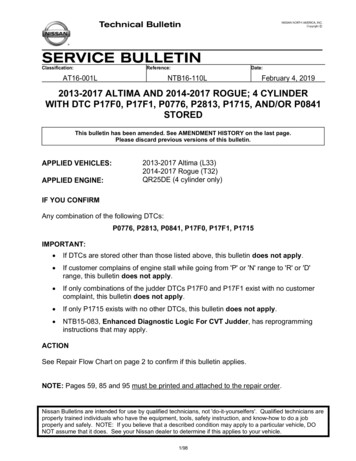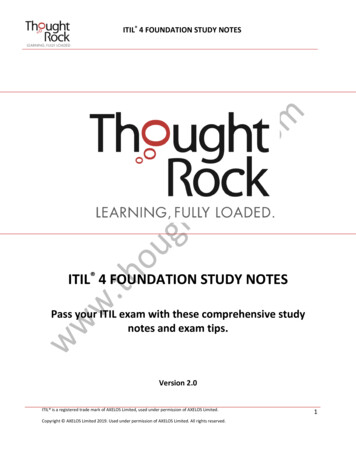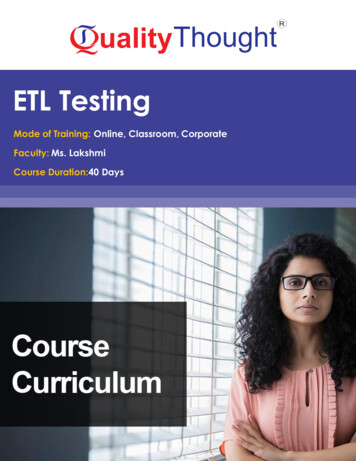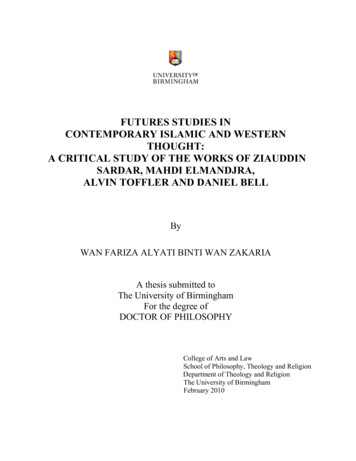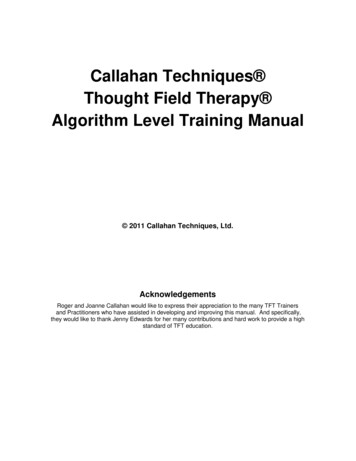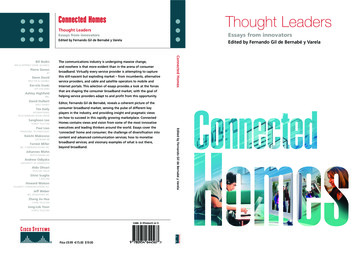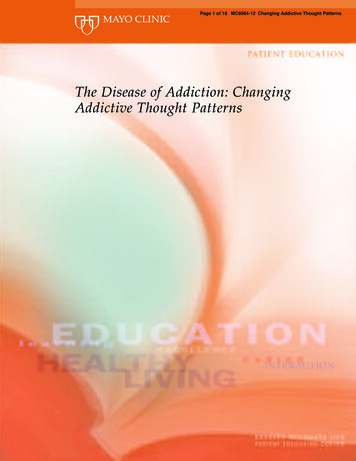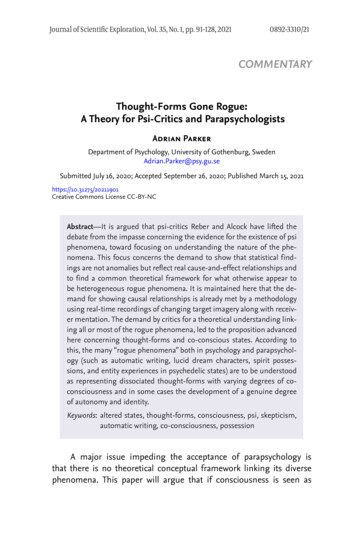
Transcription
Journal of Scientific Exploration, Vol. 35, No. 1, pp. 91–128, 20210892-3310/21COMMENTARYThought-Forms Gone Rogue:A Theory for Psi-Critics and ParapsychologistsAdrian ParkerDepartment of Psychology, University of Gothenburg, SwedenAdrian.Parker@psy.gu.seSubmitted July 16, 2020; Accepted September 26, 2020; Published March 15, 2021https://10.31275/20211901Creative Commons License CC-BY-NCAbstract—It is argued that psi-critics Reber and Alcock have lifted thedebate from the impasse concerning the evidence for the existence of psiphenomena, toward focusing on understanding the nature of the phenomena. This focus concerns the demand to show that statistical findings are not anomalies but reflect real cause-and-effect relationships andto find a common theoretical framework for what otherwise appear tobe heterogeneous rogue phenomena. It is maintained here that the demand for showing causal relationships is already met by a methodologyusing real-time recordings of changing target imagery along with receiver mentation. The demand by critics for a theoretical understanding linking all or most of the rogue phenomena, led to the proposition advancedhere concerning thought-forms and co-conscious states. According tothis, the many “rogue phenomena” both in psychology and parapsychology (such as automatic writing, lucid dream characters, spirit possessions, and entity experiences in psychedelic states) are to be understoodas representing dissociated thought-forms with varying degrees of coconsciousness and in some cases the development of a genuine degreeof autonomy and identity.Keywords: altered states, thought-forms, consciousness, psi, skepticism,automatic writing, co-consciousness, possessionA major issue impeding the acceptance of parapsychology isthat there is no theoretical conceptual framework linking its diversephenomena. This paper will argue that if consciousness is seen as
92A d r i a n Pa r k e rprimary in nature and if dissociated states are a normal characteristicof consciousness, then most of the phenomena do form a meaningfulrelationship. Many of the apparently heterogeneous phenomena inpsychology as well as in parapsychology such as automatic writing, luciddream characters, spirit possessions, and entity experiences can thenbe understood as representing dissociated thought-forms with varyingdegrees of co-consciousness and in some cases with the developmentof a genuine degree of autonomy.The importance of establishing such a theoretical frameworkis highlighted by the current critique of parapsychology as a field ofscience by Reber & Alcock (2020) (R & A), although this critique by R & Awas actually based on three grounds. These are 1) that the phenomenacontradict the limiting principles on which science is based, 2) that theclaimed psi (paranormal) effects have small effect sizes without anyshown causal relationship to reality, and 3) that there is no theoreticalconceptual framework that brings order to the chaos in the range ofalleged phenomena. The first objection from R & A was met in the2019 issue 4 of the Journal of Scientific Exploration by an Editorial andfive individual author responses, all making counterarguments to whatseemed to be R & A’s assertion that psi phenomena are “impossible”because they contradict the limiting principles of science, which haveserved science so well that they could almost be written in stone.The second objection by R & A claiming that there were onlysmall effect sizes in parapsychology was partly met by showing theirequivalence to those of other psychological findings (Williams, 2019),but the final thrust of R & A’s second argument—that the “Statisticaldepartures from chance expectation cannot and do not identify thecauses of those departures” (Reber & Alcock, 2020, p. 397)—remainsunparried. Since this is an issue that has been of some concern in ourwork at Gothenburg, some space will be given to this before proceedingto the related issue of the theoretical framework for understanding thephenomena.This challenge assumes that all the significant experimentalfindings concerning ESP may only represent unknown artifacts or“Error Some Place” rather than causal relationships. This challenge ismet if it can be shown that highly significant scores relate closely andapparently causally to the content of the experiences behind the scores.
T h o u g h t - Fo r m s G o n e R o g u e : A T h e o r y f o r Ps i C r i t i c s93The first attempt to deal with this occurred in some of the early ganzfeldwork where the descriptions from successes in the telepathy setup werepresented as voice-overs and were shown to closely match the targetfilm clips (Honorton et al., 1990). However, there remained a possiblebias in making this selection since there was no check on whether ornot the recording of the receivers’ mentation reports actually matchedin real time the content of senders’ film clips. Without this check, thematching could be seen as rather arbitrary. The series of real-timeexperiments we carried out at Gothenburg rectified this, and in doingso they deal directly with the critique of R & A concerning the lack ofconnection to reality.Indeed, the very purpose of our real-time recordings with thedigital ganzfeld was to produce the laboratory analogue of spontaneouspsychic experiences where one person (the receiver) has a psychicexperience in an altered state, usually a dream—which corresponds incontent and in time with another crisis experience of another person(the sender). In the laboratory setup this meant that we would eavesdropon the person in the altered state (the ganzfeld state) describing in thesuccessful cases the sender’s experience of an emotionally loaded filmclip. The arrangement enabled us to record both experiences precisely asthey were happening and to highlight the apparent causal relationship(Parker et al., 2000). These hits occurred when the participants notonly chose the correct clip but their descriptions seemed to closely andcausally follow unpredictable changes in the film content. About onein six of our real-time (first rank) hits were of this type. Coincidentalfalse matches did occasionally occur but these matches did not seemto show continuity in following the unexpected changes. This was adistinctive feature of genuine matches, but because of a flaw in thechoice of data used for correctly accessing this, the final evidence is stilllacking (see Parker, 2020, for a further discussion.)An ideal opportunity for dealing with R & A’s challenge, however,did arise during the ganzfeld testing of a consistently successful mother–daughter pair. I was curious to know if an unexpected intervention inthe “sender” room, where the daughter was situated and observinga film clip, would intervene in the flow of ganzfeld mentation of themother located in the “receiver” room. Without informing any of theparticipants prior to the session of my intention, I asked the daughter
94A d r i a n Pa r k e rto leave the room and a close friend of the mother to come into theroom and take over the role of sender. At precisely the point in timewhen the friend entered the room, the mother’s flow of mentationimages was interrupted and her voice was heard from the receiverroom and recorded on tape saying “Where have you been?” This wasthe only occasion when I attempted such an intervention that fits withR & A’s search for the causal effects, but others occurred spontaneouslysuch as when the tape ran out unexpectedly or the film went into slowmotion when the mentation responses were the words “change tape”and “slow motion.”The real-time digital ganzfeld does not stand alone in relatingstatistical findings to reality events. The work of James Carpenter(2012) has been outstanding in this respect, and on one occasion evenused majority voting to successfully “transmit” the code-word peace(Carpenter, 1991).I suspect that R & A would prefer to call these examples merelyweird synchronous events, in which case I would agree with theterminology. Rather than extrasensory perception, a better term forESP may indeed be Extraordinary Synchronous Phenomena. (The alertreader may ask about precognition, but this would involve a discussionof the specious presence. Although this lies beyond the scope of thisarticle, it forms a part of Carr’s theory [Carr, 2019]).The accumulation of more evidence for psi has become a Sisypheanboulder for those wishing to resolve this issue. If the boulder is now tobe moved forward, we still need to deal with the third objection.The third objection concerns the maelstrom of phenomena, oras R & A prefer to call it “the farrago.” They write: “In contemporaryparapsychology one finds a crazy quilt set of effects that have noconceivable underlying foundation. It is as if actors from a dozendifferent plays have appeared on the same stage in a discordant farrago”(Reber & Alcock, 2020, p. 393.)I agree with R & A. This issue is in dire need of being resolved. Todo so, we need to state not only how the phenomena relate to each otherbut also how they relate to other known natural phenomena. Low-levelhypotheses do already exist, as pointed out in two of the responsesto R & A (Roe, 2019; Williams, 2019). These hypotheses include therelationship to noise-reduction (Honorton, 1977; Storm et al., 2010), to
T h o u g h t - Fo r m s G o n e R o g u e : A T h e o r y f o r Ps i C r i t i c s95top-down processes (Parker, 2000), to change-in-state (Murphy, 1966;Honorton, 1977; Parker, 1975, 1994), to unconscious expectancies andbelief systems (Carpenter, 2012; Parker et al., 1997), and to morphicfields (Sheldrake, 2020). Although I have been active in formulating andtesting some of these hypotheses, I freely admit these do not provideany commonality that would link the various paranormal phenomena,and they give neither a proper theory nor a deep understanding of whatwe are dealing with.The demand to relate paranormal phenomena to knownnatural processes can be understood when the role of science fromthe Renaissance onward is seen as being “the candle in the dark.”Science has created a secure, and largely predictable, orderly world,and followers of reductionistic science have little or zero tolerance forambiguity or any retreat to the darkness of the occult. Rogue and occultphenomena can be seen as a threat to this Weltanschauung.Perhaps this is why some parapsychologists with a backgroundin physics disavow the existence of any phenomena other than ESP oreven prefer “anomalous cognition,” since this allows them to pin theirhopes on the nonlocal effects discovered in quantum physics, wherea connectedness, analogous to telepathy, occurs between particles atvarious distances. In addition, the duality of light waves and particlesseems to demand an observer, that is consciousness, in determiningthe final outcome of these processes (Marwaha & May, 2015a; Millarin Parker & Millar, 2014; Stapp, 2015). Others would go further andargue that quantum theory requires the presence of consciousness inorder to explain the transition to reality. In making these assertions,parapsychologists often cite the writings of eminent physicists such asMax Planck, Eugene Wigner, and Werner Heisenberg, who all endorsedthe view that consciousness is a primary mover in the universe (Radin,2013, 2018; van Lommel, 2020).Unfortunately, this argument is seldom well-received given thatthe majority of modern physicists appear not to share the view thatconsciousness is involved in quantum outcomes (Carr 2019; Mroczkowski& Malozemoff, 2019), although it may be more accurate to say that sucha view is rather controversial (Kastrup, 2019). What seems clear is thatmost physicists agree the bridge has not been found that would linkphenomena occurring at the quantum level to those occurring in everyday
96A d r i a n Pa r k e rhuman reality—the so-called measurement problem (Carr, 2019).Against this background, appeals to the various interpretations ofquantum theory can only strengthen any natural aversion the skepticmight have against ambiguity. Arguments about the similarity ofnonlocal effects between particles and telepathy between humans, areseen as simply attempting to explain one unknown in terms of anotherunknown.Here I will argue that the opposite tactic is more forthright andeffective. What is surely needed is an alternative view of psi that enablesus not only to explain the findings of ESP experiments but also therange of rogue phenomena in parapsychology from poltergeist casesto alleged spirit communications of mediums. I will further argue thatwe need to relate these rogue phenomena to an even wider range ofphenomena such as automatic writing, and to savant abilities, whichare a perennial challenge to clinical psychology and psychiatry. Thesituation is particularly favorable for such an approach given thatconsciousness is now a legitimate subject for scientific study. Supportfor such a starting point is found not only in the writings of theexceptional physicists named above but also in those of a few exceptionalpsychologist–philosophers such as William James and Frederic Myerswho also insisted that consciousness is primary in nature (Kelly et al.,2007).The insistence that consciousness is primary, is of course theidealist version of the panpsychism equivalent of the “one-free miracle”required by reductionism as parodied by Terence McKenna: “Give usone free miracle and we’ll explain the rest. The one free miracle is theappearance of all the mass and energy in the universe and all the lawsthat govern it in a single instant from nothing” (McKenna, in a personalcommunication with Rupert Sheldrake in 1985). The difference herewith panpsychism is that empirical work in parapsychology indicatesthat this one miracle, in this case consciousness with its attribute ofpsi, does occur.Seen from this perspective, psi is merely a sign of the fundamentalconnectedness of consciousness, and physics would then only need toenter the picture as a way for consciousness to explain nature. Thisconnectedness is most noticeable in altered states of consciousnessas illustrated by the cases reported in the spontaneous literature from
T h o u g h t - Fo r m s G o n e R o g u e : A T h e o r y f o r Ps i C r i t i c s97real life and confirmed in the laboratory by ganzfeld and altered-stateresearch (Storm et al., 2010).Of course, if we are to escape the chaos of R & A’s “farrago,”then we need to find some further commonality between laboratoryESP and the diversity of experiences such as spirit communicationsthrough mediums, mystical experiences, apparitional experiences,and poltergeist phenomena. In seeking this commonality by referringto the concept of “thought-forms,” it is not being claimed that thisprovides the ultimate sought-after deeper explanation. In order to seekthis, it may well be necessary to integrate the concept further into theframework of a theory from modern physics but one that gives primacyto a dimension of consciousness in describing the natural world (e.g.,Carr, 2019; Pilotti, 2011).THOUGHT-FORMSA thought-form has been defined as “any perceivable form, whichhas been created directly and exclusively by the mind, unconsciously orconsciously, and which in some cases develops autonomy” (Parker &Puhle, 2018). If we follow this definition, it is described in many differentcultural contexts; the most well-known examples being the Celtic andGermanic “pooka,” the Arabian “djinn,” and the Tibetan “tulpa.” Thepooka is most well-known through the works of Shakespeare, while thetulpa is attributed to Tibetan beliefs popularized by Alexandra DavidNéel. David-Néel, while travelling in the Himalayas, claimed to haveproduced a tulpa, with its own will. However, according to a recentpaper, this concept is a combination of theosophical beliefs and asomewhat misappropriated Tibetan concept (Mikles & Laycock, 2015).Nevertheless, what the concept of thought-forms brings to thedebate forum, is to view consciousness as non-unitary and potentiallydissociative and to recognize that this characteristic has various culturalexpressions. There is in fact a commonality to all this if we presupposethat there is a transpersonal or ‘extended level to consciousness,’ whichis capable of creating entities in response to extreme personal needs.Assuming this occurs, these thought-forms could in some states ofconsciousness eventually develop their own sense of identity, interactwith other persons in a meaningful way, and in some extreme casesexpress their own will.
98A d r i a n Pa r k e rAs preposterous as this may seem, there is actually consistency inmodern research concerning these aspects. As I shall now present indetail, these apparently autonomous entities are reported as occurringin a variety of altered states such as lucid dreaming (Johnson, 2017; Puhle& Parker, 2017; Tholey, 1989; Waggoner & McCready, 2015); psychedelicexperiences (Luke, 2012); and near-death-experiences (E. W. Kelly, 2001).In addition, it is being proposed here that the communicating spiritsof mediums can be explained as autonomous thought-forms gainingthe identity of deceased individuals. This means that in some cases theyare not secondary personalities or appended “alters” but have becomeindependently conscious alters.Lucid DreamingLucid dreams are dreams in which the dreamer retains the criticalability to realize that what is being experienced is a dream world andcontinues dreaming while maintaining this awareness. About 60–80%of individuals report having these experiences and about 20% havethem on a regular basis—a least once a month (Schredl & Erlacher,2004). Some individuals become adept at this and develop the abilityto maintain the states for longer periods and to steer the content anddirection of their dreams. Although lacking exact figures, it appearsclear that the majority of the adepts report experiencing so-calleddream characters.A way of understanding dream characters is to relate them to theconcept of dissociation. Dissociation is defined as “one or more parallelpaths or systems operating outside of awareness and influencingcognition, affect, or behavior” (Kirsch & Council, 1992, p. 275). The workof Harvard clinical psychologist Deirdre Barrett (1994a; 1994b; 1995;1996) is crucial here because it links dissociation to dreaming withthe starting point that “each night when we dream we manufactureothers out of parts of ourselves” (1994a, p. 123). In principle, this is thesame process of dissociation that individuals with “Dissociative IdentityDisorder” use in creating their “alters.” A confusion can occur in suchcases between what occurred in dream life and in waking life as well asin sorting out the experiences that belonged to the alter and to the hostpersonality. To clarify this, Barrett carried out a questionnaire study ofthe dream experiences reported by such individuals, which indicated
T h o u g h t - Fo r m s G o n e R o g u e : A T h e o r y f o r Ps i C r i t i c s99that 13 of the 23 patients experienced their “alters” not only in real lifebut also as dream characters. In addition, eight of these patients hadpersonalities reporting different dream memories. This led Barrett toconclude that dream characters are “normal dissociative cognitive andpersonality processes which operate largely outside consciousness.” Inwaking life these characters can occasionally break into consciousnessas dissociations (Barrett, 1995, p. 66). According to this perspective,lucid dream characters represent unexpressed parts of individuals thatgained, so to speak, their own consciousness and are a normal analogof alters.Indeed, many of the entities or characters appearing in luciddream states do assert that they have their own independent memoriesor identities. Paul Tholey, a pioneer researcher of lucid dreaming,reported that when one of the characters was questioned in the luciddream about his true identity, the character responded with: “I amsure that I have a consciousness,
Jul 16, 2020 · degrees of co-consciousness and in some cases with the development of a genuine degree of autonomy. The importance of establishing such a theoretical framework is highlighted by the current critique of parapsychology as a field of science by Reber & Alcock (2020) (R & A), although this c

